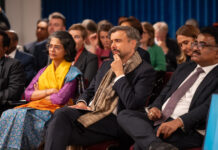
In partnership with Paboco and the three other companies in the Paboco Pioneer Community, Coca Cola has revealed a first-generation prototype of its bottle made 100% from paper – an innovative packaging technology that may help the company to achieve a World Without Waste. Coca Cola aims to collect and recycle a bottle or can for every one the company will sell by 2030, while also substantially reducing the use of virgin packaging materials and only using packaging materials 100% recyclable. It will take continuing investment in innovation, exploration of different technologies, and, crucially, partnership, and collaboration to get there.
At a lab in Brussels, Stijn and his team are working on the paper bottle prototype. “Our vision is to create a paper bottle than can be recycled like any other type of paper, and this prototype is the first step on the way to achieving this. A paper bottle opens up a whole new world of packaging possibilities, and we are convinced that paper packaging has a role to play in the future,” says Stijn Franssen, EMEA R&D Packaging Innovation manager at Coca Cola, who is working on the project.
Coca Cola mentioned that a lot of work must be done to achieve this vision of a recyclable paper bottle. The first-generation paper bottle still contains some plastic. “This first-generation paper bottle prototype still consists of a paper shell with a plastic closure and a plastic liner inside. The plastic we use is made from 100% recycled plastic that can be recycled again after use. But our vision is to create a paper bottle that can be recycled like any paper. The next step is to find a solution to create a bottle without the plastic liner,” Stijn says.
Just like other types of packaging, a paper bottle of the future must adhere to the same high safety and quality standards for food packaging that currently apply. Stijn and this team are putting the bottle through comprehensive testing in the lab to see how it performs in the refrigerator, how strong it is, and how well it protects the drinks inside.
“We also reflect on how our consumers will react to this paper bottle. Topics like when and where it could be sold and how it can be recycled are all considered. The bottle must be explored from every perspective to ensure that we make the bottle the best it can be,” says Stijn.
He is optimistic that future technological solutions will help achieve the vision of a paper bottle that’s recyclable as paper – a type of packaging technology that can be part of Coca Cola’s packaging and portfolio mix, and which could be used for a wide range of beverages. “This is all part of our journey to find the most sustainable packaging solutions for people to enjoy our drinks in a way that is right for them, and that is right for our planet,” says Stijn.
IndiFoodBev — authentic, impactful and influential
An English-language food and beverage processing and packaging industry B2B platform in print and web, IndiFoodBev is in its third year of publication. It is said that the Indian food and beverage industries represent approximately US$ 900 billion in revenues which implies more than 20% of the country’s GDP. Eliminating the wastage on the farmside can help to deliver more protein to a higher number of the population apart from generating sizable exports. The savings in soil, seeds, water, fertilizer, energy and ultimately food and nutrition could be the most immense contribution that country is poised to make to the moderation of climate change.
To improve your marketing and grow sales to the food and beverage processing and packaging industry, talk to us. Our research and consulting company IppStar [www.ippstar.org] can assess your potential and addressable markets in light of the competition. We can discuss marketing, communication, and sales strategies for market entry and growth.
Suppliers and service providers with a strategy and budget for targeted marketing can discuss using our hybrid print, web, video, and social media channels to create brand recognition linked to market relevance. Our technical writers are ready to meet you and your customers for content.
The second largest producer of fruit and vegetables in the world is continuously expanding processing capacities and delivery systems with appropriate innovative technologies. We cover product and consumer trends, nutrition, processing, research, equipment and packaging from farm to thali. Get our 2025 media kit and recalibrate your role in this dynamic market. Enhance your visibility and relevance to existing markets and turn potential customers into conversations. Ask for a sample copy of our bi-monthly in print or our weekly IndiFoodBev eZine each Wednesday.
For editorial info@ippgroup.in — for advertisement ads1@ippgroup.in and for subscriptions subscription@ippgroup.in
Naresh Khanna – 10 February 2025
Subscribe Now










